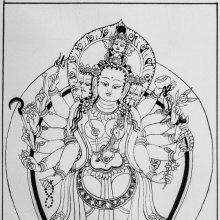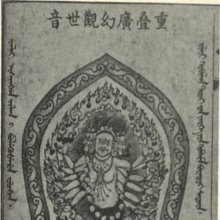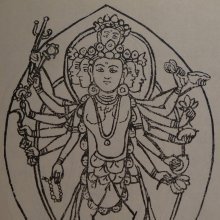Mayajalakrama, Māyājālakrama: 1 definition
Introduction:
Mayajalakrama means something in Buddhism, Pali. If you want to know the exact meaning, history, etymology or English translation of this term then check out the descriptions on this page. Add your comment or reference to a book if you want to contribute to this summary article.
Images (photo gallery)
In Buddhism
Tibetan Buddhism (Vajrayana or tantric Buddhism)
Source: archive.org: The Indian Buddhist Iconography1) Māyājālakrama (मायाजालक्रम) or Māyājālakramalokeśvara refers to one of the various forms of Avalokiteśvara having their Sādhana described in the 5th-century Sādhanamālā (a collection of sādhana texts that contain detailed instructions for rituals).—His Colour is blue; his Āsana is the pratyālīḍha; He has five faces and twelve hands.—As the Sādhana for the worship of this particular form of Avalokiteśvara, occurs originally in the Māyājāla-tantra, this peculiar name has been given to the deity. This is the only fierce form of Lokeśvara known to the Indian Buddhists, although fiercer forms are to be met with in the Tibetan Buddhist Iconography.
The Dhyāna (meditation instructions) of Māyājālakrama is described in the Sādhanamālā as follows:
“The worshipper should think himself as Ārya-Avalokiteśvara, whose colour is blue. He stands in the pratyālīḍha attitude, on the orb of the sun. He is five-faced, three-eyed, twelve-armed, with the two right faces of white and red colour, and two left of yellow and green colour. He carries in his right hands the 1. ḍamaru, 2. the khaṭvāṅga, 3. the goad, 4. the noose, 5. the vajra and the 6. the arrow, and in the left hands the 1. raised index finger, 2. the kapāla, 3. the red lotus, 4. the jewel, 5. the discus, and 6. the bow. His faces look terrible with bare fangs. He wears the six bone ornaments and his person is embellished by the garland of heads. He is nude and appears beautiful in all limbs. Thus quickly meditating...”.
2) Māyājālakrama (मायाजालक्रम) or Māyājālakramakurukullā refers to one of the names of Kurukullā: one of the various (female) emanations of Amitābha having their Sādhana described in the 5th-century Sādhanamālā (a collection of sādhana texts that contain detailed instructions for rituals).—Her Colour is red; her Āsana is the vajraparyaṅka; she has six arms.—Another form of Kurukullā is known as Māyājālakrama Kurukullā since the Sādhana describing it is said to have been restored from the now lost Māyājāla-tantra by the Tantric author Kṛṣṇācārya.
3) Māyājālakrama (मायाजालक्रम) or Māyājālakramalokeśvara refers to number 5 of the 108 forms of Avalokiteśvara found in the Machhandar Vahal (Kathmanu, Nepal). [Machhandar or Machandar is another name for for Matsyendra.].
Accordingly,—
“Māyājālakrama has five faces and twelve arms. The head on the top probably represents Amitābha. He stands in the Ālīḍha attitude, and wears the tiger-skin and the garland of heads, but his faces do not present a fearful appearance. The six right hands carry the Tridaṇḍī, the Khaṭvāṅga, the jewel, the Khaḍga, the Vajra and the rosary, and the six left show the noose, the Kapāla, the Utpala, the fruit, the Cakra and the lotus”.
The names of the 108 deities [viz., Māyājālakrama] possbily originate from a Tantra included in the Kagyur which is named “the 108 names of Avalokiteshvara”, however it is not yet certain that this is the source for the Nepali descriptions. Tibetan Buddhism includes schools such as Nyingma, Kadampa, Kagyu and Gelug. Their primary canon of literature is divided in two broad categories: The Kangyur, which consists of Buddha’s words, and the Tengyur, which includes commentaries from various sources. Esotericism and tantra techniques (vajrayāna) are collected indepently.
See also (Relevant definitions)
Starts with: Mayajalakramakrodha, Mayajalakramakrodhalokeshvara, Mayajalakramakurukulla, Mayajalakramalokeshvara.
Full-text: Mayajalakramalokeshvara, Mayajalakramakurukulla, Kurukulla.
Relevant text
Search found 1 books and stories containing Mayajalakrama, Māyājālakrama; (plurals include: Mayajalakramas, Māyājālakramas). You can also click to the full overview containing English textual excerpts. Below are direct links for the most relevant articles:
The Indian Buddhist Iconography (by Benoytosh Bhattachacharyya)
Related products


